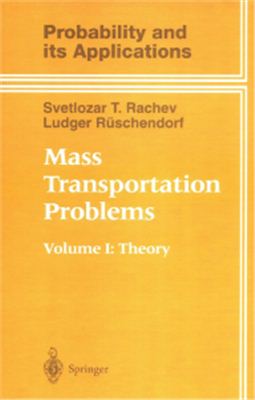Springer, 1998, Pages: 430.
The first comprehensive account of the theory of mass transportation problems and its applications. In Volume I, the authors systematically develop the theory with emphasis on the Monge-Kantorovich mass transportation and the Kantorovich-Rubinstein mass transshipment problems. They then discuss a variety of different approaches towards solving these problems and exploit the rich interrelations to several mathematical sciences - from functional analysis to probability theory and mathematical economics. The second volume is devoted to applications of the above problems to topics in applied probability, theory of moments and distributions with given marginals, queuing theory, risk theory of probability metrics and its applications to various fields, among them general limit theorems for Gaussian and non-Gaussian limiting laws, stochastic differential equations and algorithms, and rounding problems. Useful to graduates and researchers in theoretical and applied probability, operations research, computer science, and mathematical economics, the prerequisites for this book are graduate level probability theory and real and functional analysis.
The first comprehensive account of the theory of mass transportation problems and its applications. In Volume I, the authors systematically develop the theory with emphasis on the Monge-Kantorovich mass transportation and the Kantorovich-Rubinstein mass transshipment problems. They then discuss a variety of different approaches towards solving these problems and exploit the rich interrelations to several mathematical sciences - from functional analysis to probability theory and mathematical economics. The second volume is devoted to applications of the above problems to topics in applied probability, theory of moments and distributions with given marginals, queuing theory, risk theory of probability metrics and its applications to various fields, among them general limit theorems for Gaussian and non-Gaussian limiting laws, stochastic differential equations and algorithms, and rounding problems. Useful to graduates and researchers in theoretical and applied probability, operations research, computer science, and mathematical economics, the prerequisites for this book are graduate level probability theory and real and functional analysis.

